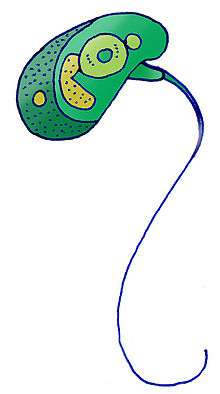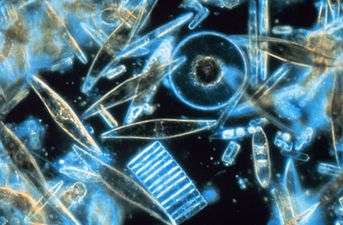Prasinophyceae
The Prasinophytes (incl. Tetraphytina) or chlorophyta are a class of unicellular green algae.[2] Prasinophytes mainly include marine planktonic species, as well as some freshwater representatives.[2][3] The prasinophytes are morphologically diverse, including flagellates with one to eight flagella and non-motile (coccoid) unicells. The cells of many species are covered with organic body scales; others are naked.[3] Well studied genera include Ostreococcus, considered to be the smallest (ca. 0.95 μm) free-living eukaryote,[4] and Micromonas, both of which are found in marine waters worldwide. Prasinophytes have simple cellular structures, containing a single chloroplast and a single mitochondrion. The genomes are relatively small compared to other eukaryotes (about 12 Mbp for Ostreococcus[5][6] and 21 Mbp for Micromonas[7]).
| Prasinophyceae | |
|---|---|
 | |
| Pyramimonas sp. | |
| Scientific classification | |
| Kingdom: | |
| Division: | |
| Class: | Prasinophyceae T.Christensen ex P.C.Silva 1980 |
| Orders[1] | |
Some authors treat the prasinophytes as a polyphyletic grouping of green algae from different clades. As the Tetraphytina emerged in the Prasinophytes, recently authors include it, rendering it monophyletic, and equivalent to chlorophyta.[8][9]
Ecology

A study of photosynthetic gene-sequence diversity (rbcL) in the Gulf of Mexico indicated that Prasinophytes are particularly prevalent at the Subsurface Chlorophyll Maximum (SCM)[10] and several different ecotypes of Ostreococcus have been detected in the environment.[11] These ecotypes were thought to be distinguished in the environment by their adaptation to light intensities. O. lucimarinus was isolated from a high-light environment[12] and observed year-round in the coastal North Pacific Ocean.[13] RCC141 was considered low-light, because it was isolated from the lower euphotic zone. These strains, or ecotypes, were later shown to live in different habitats (open-ocean or mesotrophic) and their distributions do not appear to be connected to light availability.[14] O. tauri was isolated from a coastal lagoon and appears to be light-polyvalent. Genetic data indicates that distinct molecular differences exist between the different ecotypes that have been detected.[15]
Prasinophytes are subject to infection by large double-stranded DNA viruses belonging to the genus Prasinovirus in the family Phycodnaviridae,[16][17][18] as well as a Reovirus.[19] It has been estimated that from 2 to 10% of the Micromonas pusilla population is lysed per day by viruses.[20]
Phylogeny
Recent studies agree that the prasinophytes are not a natural group, being highly paraphyletic.[3][21][22][23] Relationships among the groups making up the Chlorophyta are not fully resolved. The cladogram produced by Leliaert et al. 2011[3] and some modification according to Silar 2016,[24] Leliaert 2016[25] and Lopes dos Santos et al. 2017[26] is shown below. The blue shaded groups are or have traditionally been placed in the Prasinophyceae[2]). The species Mesostigma viride has been shown to be a member of the Streptophyta or basal Green algae. The others are member of the Chlorophyta.
| Green Algae |
| ||||||||||||||||||||||||||||||||||||||||||||||||||||||||||||||||||||||||||||||||||||||||||||||||||||||||||||||||||||||||
References
- Guiry, M.D. & Guiry, G.M. (2007). "Class: Prasinophyceae taxonomy browser". AlgaeBase version 4.2 Worldwide electronic publication, National University of Ireland, Galway. Retrieved 2007-09-23.
- Sym, S. D. and Pienaar, R. N. 1993. The class Prasinophyceae. In Round, F. E. and Chapman, D. J. (eds) Progress in Phycological Research, Vol. 9. Biopress Ltd., Bristol, pp. 281-376.
- Leliaert F, Verbruggen H, Zechman FW (September 2011). "Into the deep: new discoveries at the base of the green plant phylogeny". BioEssays. 33 (9): 683–92. doi:10.1002/bies.201100035. PMID 21744372.
- Courties C, Vaquer A, Troussellier M, Lautier J, Chrétiennot-Dinet MJ, Neveux J, et al. (1994). "Smallest eukaryotic organism". Nature. 370 (6487): 255. Bibcode:1994Natur.370..255C. doi:10.1038/370255a0.
- Derelle E, Ferraz C, Rombauts S, Rouzé P, Worden AZ, Robbens S, Partensky F, Degroeve S, Echeynié S, Cooke R, Saeys Y, Wuyts J, Jabbari K, Bowler C, Panaud O, Piégu B, Ball SG, Ral JP, Bouget FY, Piganeau G, De Baets B, Picard A, Delseny M, Demaille J, Van de Peer Y, Moreau H (August 2006). "Genome analysis of the smallest free-living eukaryote Ostreococcus tauri unveils many unique features". Proceedings of the National Academy of Sciences of the United States of America. 103 (31): 11647–52. Bibcode:2006PNAS..10311647D. doi:10.1073/pnas.0604795103. PMC 1544224. PMID 16868079.
- Palenik B, Grimwood J, Aerts A, Rouzé P, Salamov A, Putnam N, et al. (May 2007). "The tiny eukaryote Ostreococcus provides genomic insights into the paradox of plankton speciation". Proceedings of the National Academy of Sciences of the United States of America. 104 (18): 7705–10. Bibcode:2007PNAS..104.7705P. doi:10.1073/pnas.0611046104. PMC 1863510. PMID 17460045.
- Worden AZ, Lee JH, Mock T, Rouzé P, Simmons MP, Aerts AL, et al. (April 2009). "Green evolution and dynamic adaptations revealed by genomes of the marine picoeukaryotes Micromonas". Science. 324 (5924): 268–72. Bibcode:2009Sci...324..268W. doi:10.1126/science.1167222. PMID 19359590.
- Tevatia R, Oyler GA (2018-01-02). "Evolution of DDB1-binding WD40 (DWD) in the viridiplantae". PLOS ONE. 13 (1): e0190282. Bibcode:2018PLoSO..1390282T. doi:10.1371/journal.pone.0190282. PMC 5749748. PMID 29293590.
- Rockwell NC, Martin SS, Li FW, Mathews S, Lagarias JC (May 2017). "The phycocyanobilin chromophore of streptophyte algal phytochromes is synthesized by HY2". The New Phytologist. 214 (3): 1145–1157. doi:10.1111/nph.14422. PMC 5388591. PMID 28106912.
- Wawrik B, Paul JH, Campbell L, Griffin D, Houchin L, Fuentes-Ortega A, Müller-Karger F (2003). "Vertical Structure of the Phytoplankton Community Associated with a Coastal Plume in the Gulf of Mexico". Marine Ecology Progress Series. 251: 87–101. Bibcode:2003MEPS..251...87W. doi:10.3354/meps251087.
- Guillou L, Eikrem W, Chrétiennot-Dinet MJ, Le Gall F, Massana R, Romari K, Pedrós-Alió C, Vaulot D (June 2004). "Diversity of picoplanktonic prasinophytes assessed by direct nuclear SSU rDNA sequencing of environmental samples and novel isolates retrieved from oceanic and coastal marine ecosystems". Protist. 155 (2): 193–214. doi:10.1078/143446104774199592. PMID 15305796.
- Worden AZ, Nolan JK, Palenik B (2004). "Assessing the dynamics and ecology of marine picophytoplankton: The importance of the eukaryotic component". Limnology and Oceanography. 49 (1): 168–179. Bibcode:2004LimOc..49..168W. doi:10.4319/lo.2004.49.1.0168.
- Worden AZ (2006). "Picoeukaryote diversity in coastal waters of the Pacific Ocean" (PDF). Aquatic Microbial Ecology. 43 (2): 165–175. doi:10.3354/ame043165.
- Demir-Hilton E, Sudek S, Cuvelier ML, Gentemann CL, Zehr JP, Worden AZ (July 2011). "Global distribution patterns of distinct clades of the photosynthetic picoeukaryote Ostreococcus". The ISME Journal. 5 (7): 1095–107. doi:10.1038/ismej.2010.209. PMC 3146286. PMID 21289652.
- Rodríguez F, Derelle E, Guillou L, Le Gall F, Vaulot D, Moreau H (June 2005). "Ecotype diversity in the marine picoeukaryote Ostreococcus (Chlorophyta, Prasinophyceae)". Environmental Microbiology. 7 (6): 853–9. doi:10.1111/j.1462-2920.2005.00758.x. PMID 15892704.
- Mayer JA, Taylor FJ (1979). "A virus which lyses the marine nanoflagellate, "Micromonas pusilla"". Nature. 281 (5729): 299–301. Bibcode:1979Natur.281..299M. doi:10.1038/281299a0.
- Cottrell MT, Suttle CA (1991). "Wide-spread occurrence and clonal variation in viruses which cause lysis of a cosmopolitan, eukaryotic marine phytoplankter, "Micromonas pusilla"". Marine Ecology Progress Series. 78: 1–9. Bibcode:1991MEPS...78....1C. doi:10.3354/meps078001.
- Bellec L, Grimsley N, Derelle E, Moreau H, Desdevises Y (April 2010). "Abundance, spatial distribution and genetic diversity of Ostreococcus tauri viruses in two different environments". Environmental Microbiology Reports. 2 (2): 313–21. doi:10.1111/j.1758-2229.2010.00138.x. PMID 23766083.
- Attoui H, Jaafar FM, Belhouchet M, de Micco P, de Lamballerie X, Brussaard CP (May 2006). "Micromonas pusilla reovirus: a new member of the family Reoviridae assigned to a novel proposed genus (Mimoreovirus)". The Journal of General Virology. 87 (Pt 5): 1375–83. doi:10.1099/vir.0.81584-0. PMID 16603541.
- Cottrell MT, Suttle CA (1995-06-01). "Dynamics of lytic virus infecting the photosynthetic marine picoflagellate "Micromonas pusilla"". Limnology and Oceanography. 40 (4): 730–739. Bibcode:1995LimOc..40..730C. CiteSeerX 10.1.1.517.2324. doi:10.4319/lo.1995.40.4.0730. ISSN 1939-5590.
- Lewis LA, McCourt RM (October 2004). "Green algae and the origin of land plants". American Journal of Botany. 91 (10): 1535–56. doi:10.3732/ajb.91.10.1535. PMID 21652308.
- Becker B, Marin B (May 2009). "Streptophyte algae and the origin of embryophytes". Annals of Botany. 103 (7): 999–1004. doi:10.1093/aob/mcp044. PMC 2707909. PMID 19273476.
- Marin B (September 2012). "Nested in the Chlorellales or independent class? Phylogeny and classification of the Pedinophyceae (Viridiplantae) revealed by molecular phylogenetic analyses of complete nuclear and plastid-encoded rRNA operons". Protist. 163 (5): 778–805. doi:10.1016/j.protis.2011.11.004. PMID 22192529.
- Silar, Philippe (2016), "Protistes Eucaryotes: Origine, Evolution et Biologie des Microbes Eucaryotes", HAL Archives-ouvertes: 1–462
- Leliaert F, Tronholm A, Lemieux C, Turmel M, DePriest MS, Bhattacharya D, Karol KG, Fredericq S, Zechman FW, Lopez-Bautista JM (May 2016). "Chloroplast phylogenomic analyses reveal the deepest-branching lineage of the Chlorophyta, Palmophyllophyceae class. nov". Scientific Reports. 6 (1): 25367. Bibcode:2016NatSR...625367L. doi:10.1038/srep25367. PMC 4860620. PMID 27157793.
- Lopes Dos Santos A, Pollina T, Gourvil P, Corre E, Marie D, Garrido JL, Rodríguez F, Noël MH, Vaulot D, Eikrem W (October 2017). "Chloropicophyceae, a new class of picophytoplanktonic prasinophytes". Scientific Reports. 7 (1): 14019. Bibcode:2017NatSR...714019L. doi:10.1038/s41598-017-12412-5. PMC 5656628. PMID 29070840.
External links
| Wikispecies has information related to Prasinophyceae |
| Wikimedia Commons has media related to Prasinophyceae. |
